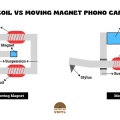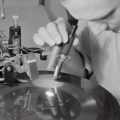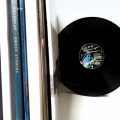What with the present vinyl boom occurring throughout the western world, you would be forgiven for asking, ‘just how are vinyl records made?’ These are things that can very easily be taken for granted, and learning about the way that the world works and functions seems only right.
In fact, it ought to be part of a healthy relationship with the world and the surroundings around us. How else are you as a human supposed to empathize with those around you if you don’t even know how the record currently spinning on your turntable platter came to be in the first place?!
It is precisely this dissociation that is wreaking havoc among younger generations of consumers today.
Whether through the internet or by other means entirely (cough cough pandemic), more and more people are at a remove from their surroundings, from their fellow humans, and from the world in which they live. More and more often, these people are locking themselves away, ordering food and deliveries online, and forgetting the world actually exists outside of their simulation of choice.
Let us change this, one industry at a time, and take a deep dive into “How Are Vinyl Records Made?”
Table of Contents
- First Steps to How Are Vinyl Records Made
- How Are Vinyl Records Made When Vinyl Is So Different
- His Master’s Version of How Are Vinyl Records Made
- More Discs
- How Are Vinyl Records Made? Printing and Pressing, That’s How!
- Finishing Touches
- Final Tones
- FAQs How Are Vinyl Records Made
First Steps to How Are Vinyl Records Made
So, how are vinyl records made? Once an album is recorded and mixed, and the artist and producer are satisfied with the result, the music’s journey has only just begun. Now, it must go to a mastering engineer. Sometimes this can be the producer themselves, though it is best to have a separate pair of ears on a project. This engineer will give everything a final polishing in terms of frequency range and dynamics.
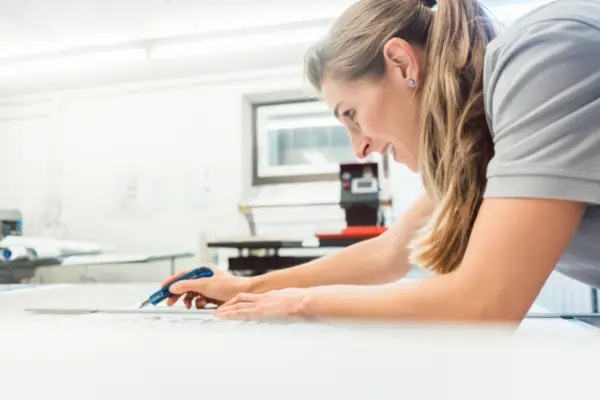
For most releases, the levels and the tonality between songs are going to want to be consistent throughout, and it is the mastering engineer’s job to ensure this before releasing the project out into the big wide world. This stage of mastering is vital for the professional release of an album, regardless of whether it will be released on a physical medium such as tape and vinyl, or wholly digitally.
How Are Vinyl Records Made When Vinyl Is So Different
The sonic contexts for releases will greatly affect the engineering that the master will need. Vinyl is inherently different from other mediums, both in good and bad ways:
- Because the vinyl record is such a physical medium, relying on the tracking of grooves with a stylus, the frequency range is considerably reduced, especially in comparison to digital recording. If you have ever had extraneous vibrations knock your stylus from its course, then you will have some idea of the effect that more intense frequencies can have on said stylus if not properly tamed in this mastering process.]
- Because of the vinyl disc’s inherently circular shape, there are smaller grooves towards the center of the disc. On the outside of a 12-inch record, the needle moves at around 20 inches per second. On the inside, however, it moves at around 8 1/2 inches per second. With smaller grooves comes a reduction in audio fidelity, and this is something that the mastering engineer has to take into account. The artist and producer even, in some cases, are forced to choose a song order with this in mind, knowing that those on the inner grooves of the disc won’t sound as crisp nor clear.
- Because of its physical medium, the amount of music that a vinyl disc can hold is finite. The stylus will eventually reach an end and will require you the listener to either flip the disc or pause and reflect on what you just heard. As a result, the artist and producer also need to consider the time factor when creating the song order and deciding which songs will go on which side of the record, often splitting the time down the middle between the tracklist.
- For similar reasons, the vinyl record’s dynamic range is also considerably smaller than a digital recording. A record mastered too loud will sound distorted, and a record mastered with too many large dynamic crescendos will skip and cause the stylus to jump as though in fright. Thus, the louder a record is the deeper its grooves need to be to represent and contain this volume, meaning less space on each side of the record.
His Master’s Version of How Are Vinyl Records Made
When the mastering engineer is satisfied, the master disc will be created, an aluminum plate covered in a thick coat of lacquer, from which all the other records are printed and produced. Some mastering engineers, in fact, do this themselves, though it is more common to pass this responsibility on to others for whom it is their specialty.
The audio is sent through a cutting lathe. This large specialized machine has a sharp head with a tiny stylus usually made from sapphire, performing the opposite of what a stylus would on a turntable. Where the stylus turns grooves into vibrations into sound, the lathe turns vibrations into the grooves of the master disc. The stylus gets so hot during the cutting process that it has to be cooled with helium gas the entire time to avoid a fire!
This cutting process is performed in real-time while the music is playing. One of the more crucial tasks for the engineer at this point, other than preventing a massive fire of course, is to make sure that separate spaces are created between songs. These very physical and visual gaps on a record are, in fact, created by hand, the individual hand and eye coordination of its engineer to be precise, manually scrolling the stylus ever so slightly more towards the center of the record.
More Discs
From this master disc, another disc is produced, called a ‘stamper’ disc. After being carefully washed so that as much dust is kept off as possible, the master disc is sprayed with silver. Following this, it is submerged in a nickel bath and electroplated, the process of electroplating causes this nickel to fill the grooves on the disc like reimbursed trenches.

The electroplated master disc is then pulled apart, so that you are left with two discs that should be mirror images of each other, one being the original lacquer master disc with grooves, the other being its polar opposite in shape, with ridges instead of grooves. This latter disc, with the ridges instead of the grooves, is what is referred to as the ‘father’ disc, and is what gets used in the production of vinyl records, to stamp its impression into the hot wax
At every stage in the process of how are vinyl records made, extra care and checks are implemented to make sure that there are not any errors in the process, and that damages have not been accrued as it has gone along. At this point, for example, the master disc is checked to make sure there are no errors. However, since the electroplating, the master disc is not suitable for this, nor is the newly created father disc. Therefore, this new father disc must be electroplated once more and split apart, to create a mother disc with all the grooves of the original.
How Are Vinyl Records Made? Printing and Pressing, That’s How!
Here, the pressing begins! The stamper disc created above is only good for so long. Trade secrets suggest that after one thousand vinyl records are created from this stamper copy, the audio quality of the ridges starts to degrade. Thus, a new version must be created after it has been used this many times, and a new stamper copy made by electroplating and splitting the mother disc once again.
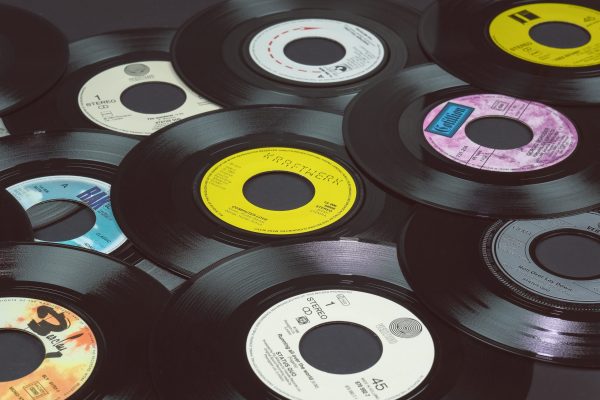
Pellets of polyvinyl chloride are loaded into a hopper on the record press and melted and squeezed into what those in the trade frequently refer to as a ‘biscuit’ – a blob of the precious vinyl shaped like a hockey puck.
The stamper discs are loaded above and below this plastic puck, one for each side of the album, pressing the grooves into the vinyl. The labels are also added at this stage, technicians having to bake the labels in advance to get all the moisture out of them, so that they don’t bubble when pressed onto the vinyl by the machine.
The two stampers come together with heat and around 100 tons of pressure, flattening out the plastic into the shape of its impression, simultaneously implementing the labels into their respective spots at the center of the disc. The machine then trims of the excesses at the edges, cooling the new disc with water, all of this taking about thirty seconds.
The machine repeatedly reloads new biscuits of vinyl plastic and labels, repeating the pressing process until the desired number of copies is reached.
Finishing Touches
Before shipping to consumers, test pressings are made so that the artist, producer, record label (and whoever else) can listen to them to make sure they are as close to their original artistic intention as possible. Once this pressing has been met with their approval, the signal to go is given and all the copies that have been ordered are produced.
The newly printed records are placed into their inner jacket and then into album covers, shrink-wrapped finally in thin plastic, and emblazoned with whatever stickers the record label has seen fit to use to promote the damn thing. After that, the rest is your story, whatever you the consumer make of it.
Final Tones
So, there you have it! I hope this comprehensive guide to the mastering and manufacture of vinyl records has been as useful as possible in helping you to decipher just exactly ‘how are vinyl records made’.
FAQs How Are Vinyl Records Made
What is vinyl record made of?
This seminal and unavoidable material, polyvinyl chloride, is at its most simple produced through the combination of crude oil and chlorine, at the root of what are vinyls. The name polyvinyl chloride might even feel somewhat familiar, even if you have not necessarily heard it in this guise before. A lot of plumbing and other things around the house (and elsewhere for that matter) are made with the very same material, though it is more often referred to as PVC. Sound familiar? I thought so.
How is a vinyl record pressed?
Melted and squeezed into what those in the trade frequently refer to as a ‘biscuit’ – a blob of the precious vinyl shaped like a hockey puck. The stamper discs are loaded above and below this plastic puck, one for each side of the album, pressing the grooves into the vinyl. The labels are also added at this stage, technicians having to bake the labels in advance to get all the moisture out of them, so that they don’t bubble when pressed onto the vinyl by the machine. The two stampers come together with heat and around 100 tons of pressure, flattening out the plastic into the shape of its impression, simultaneously implementing the labels into their respective spots at the center of the disc. The machine then trims of the excesses at the edges, cooling the new disc with water, all of this taking about thirty seconds.
What are vinyl records actually made of?
This seminal and unavoidable material, polyvinyl chloride, is at its most simple produced through the combination of crude oil and chlorine, at the root of what are vinyls. The name polyvinyl chloride might even feel somewhat familiar, even if you have not necessarily heard it in this guise before. A lot of plumbing and other things around the house (and elsewhere for that matter) are made with the very same material, though it is more often referred to as PVC. Sound familiar? I thought so.


